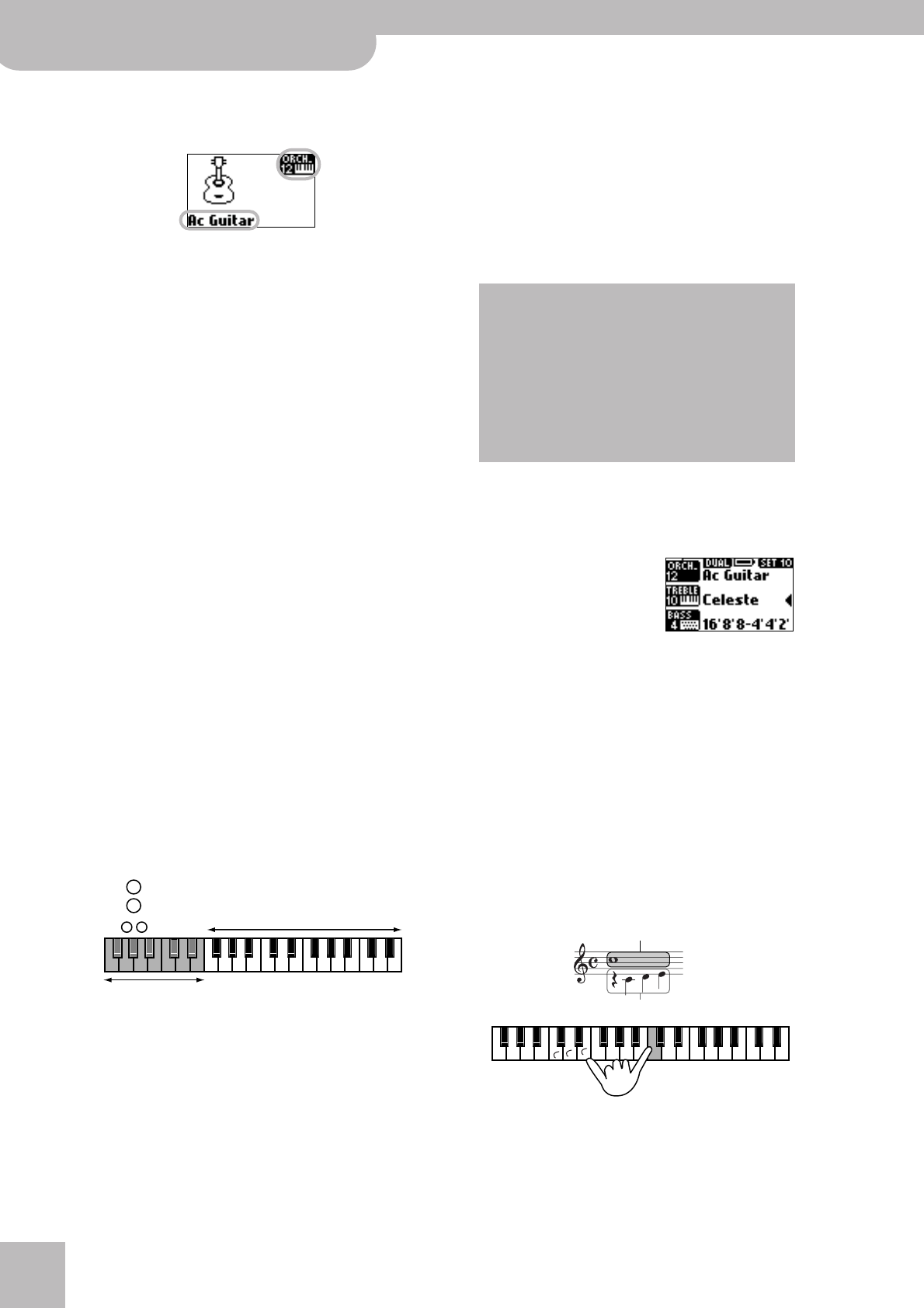
Setting up | Using the orchestral sounds
26
r
FR-7/FR-5 V-Accordion
The display briefly confirms your selection and shows
both the name of the sound you selected and the
number of the register you pressed:
(3) Play a few notes on the Treble keyboard.
The Treble keyboard is velocity sensitive. The volume
and timbre of the notes played by the Orchestra part
depend on how hard/fast you press the treble keys
(for sounds 11, 12 or 13).
Note: The Treble accordion does not respond to velocity infor-
mation generated by the keyboard. You can, however, vary its
volume and timbre by pressing/pulling the bellows harder and
softer (like on a “real” accordion).
The Treble keyboard also generates aftertouch mes-
sages. “Aftertouch” refers to the fact that you press a
key even further down after playing a note. For some
orchestral sounds (guitar, flute, etc.) as well as for the
Treble accordion section, this effect allows you to
bend the pitch down (temporarily lower the note). If
you select an organ sound, aftertouch can be used to
switch between the fast and slow Rotary effect
speeds.
Note: This aftertouch effect applies to all notes that are
sounding simultaneously. If you play a chord and then only
press down one key of the chord’s constituent notes, all notes
are bent by the same amount. (MIDI buffs call this “channel
aftertouch”.)
■About the ‘HighLand’ and ‘Zampogna’ sounds
Your FR-7/FR-5 contains two bagpipe-instrument
sounds, one called “HighLand”, the other called
“Zampogna”. The instruments on which those sounds
are based use one or several drone notes over which
the melody is played.
To recreate the same sensation on the FR-7/FR-5, the
lowest octave on the Treble keyboard is assigned to
the drone notes when you select one of these
sounds:
Here is how the drone function works:
• If you press a single gray key (see the illustration),
only that note is held. You can release the key imme-
diately after playing the note – it will be held indefi-
nitely.
• If you press two (or more) keys simultaneously, those
notes are held (the drone function is polyphonic).
• To switch off the currently sounding drone note(s),
either press another key in the gray area (switch to
another drone note) or press the key(s) of the sound-
ing drone notes again to stop the drone.
■Selecting the Orchestra mode
Depending on the settings of the Set you selected,
the Orchestra part may sound together with the Tre-
ble accordion section. That’s because there are four
ways in which the Orchestra section can be combined
with the Treble accordion section.
SOLO [14]: When you switch on the Orchestra section
(see step (2) above), you only hear the orchestral
instrument sound. Press [CANCEL] to return to the
Treble accordion sound.
DUAL [13]: The orchestral
sound is added to the Treble
accordion, so that each note
you play sounds like an accor-
dion, with the selected instru-
ment playing in unison.
Just as a reminder: here, both the ORCH and TREBLE
fields contain a keyboard icon to indicate that they
sound simultaneously.
HIGH [12]: Now it becomes a little more complicated
– but very interesting indeed. If you select this mode
and play just one note, it is sounded by the orchestral
sound. If you keep holding that key while pressing
another (lower) key to its left, the upper note is
played by the orchestral sound. Lower notes, how-
ever, are played by the Treble accordion sound. This is
perfect for situations where you need to play chords
and a solo line using different sounds. Something like
this:
Can be used to play the melody.
Sound the drone notes.
If the Orchestra part is off (set to CANCEL), the Mas-
ter bar always recalls the Treble register selected
with “Master Bar Recall” (page 67).
After selecting one of the modes (DUAL, HIGH, LOW,
or SOLO) and switching on the Orchestra part (CAN-
CEL off), the Master bar allows you to switch the
Orchestra part on and off. In SOLO mode, this means
that you alternate between the Treble and Orchestra
parts.
Played by the Orchestra sound
Played by the accordion


















